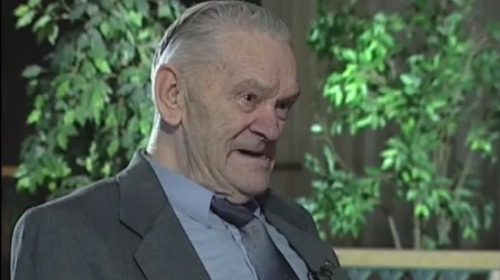.303 Pull!
Heroes Remember
.303 Pull!
Transcript
Interviewer: But how did they train you to jump out of an
air plane?
Well, you did that with practice by a plane in a, stationed in a
hangar. You know what the hanger is? We used to jump on rubber,
on mattresses, to give us landing... teaching us how to
jump properly.
Interviewer: And then what?
Then, whenever that's done, I'd quit doing that. We went up and
did the real thing.
Interviewer: You must have been a little scared the first time
you jumped?
I don't know, I don't remember. I did it without trouble, anyway.
Interviewer: So, when you jumped, you had your kit bag? What else
did you have with you?
Well, a map tacked on the, on the back, but that's all.
Interviewer: And what about a weapon? Where was your weapon?
Well, it, it was... It, it was a weapon where you could, could
assemble it, and that was in your kit bag.
Interviewer: Oh. OK. Now, when you jumped from the air plane,
when did the parachute open?
When you're down the slipstream. You know what the slipstream is,
don't you?
Interviewer: Well, tell me about the slipstream. Tell me what it,
what it is.
Well, it was whishhhh, a hissing sound in your ears when you left
the plane, you won't forget this, when you left the plane, you're
travelling the same speed as the plane. So if the plane was doing
500 miles an hour, you're doing 500 miles per hour. ‘Course
that's just while you're in the slipstream.
Interviewer: And then how did you know, how would you know when
you were ready to pull the, open the chute?
It's at .303. That's the name of the ammunition, as you know,
.303. ".303 pull." And that undid your, that undid your chute.
".303 pull."
Interviewer: And what did the ground look like when the, right
before you jumped. Did you look out the air plane? (Oh, yeah.)
Interviewer: And what did you see?
See, everything was so small. Soon as you leave the plane, you
look out there. Things are so small, and as you get lower, lower
down, things got bigger.
Interviewer: And how did you get ready to land?
Well, we had a, a kit bag. You know the ordinary kit bag is?
It had a recess, where you could put your foot and leg in, and
there it was a kind of a zipper, zipper on there, and you undid
the zipper, and you kicked it and that, that... You, your kit
bag closing on its own, but it was attached with a, a cord.
Interviewer: And, so, how did you land? What, what did you have
to do to land? You're holding the para- parachute.
Well, it's tough to explain.
You pull your lift web up, when you're landing one way, whether,
whether, whether you got the help of the wind.
You could pull your front lift web or your, or your rear ones,
and that's used to alter your course.
Interviewer: How did you feel after your very first jump? Do you
remember how you felt when you, your first jump?
I, I, I felt . . . Don't forget, I'm only 18 years old.
No, we were pleased.
Description
Mr. Wright describes the training required to become a paratrooper.
Norm Wright
Mr. Wright was born in Scafford, England in 1923. He was one of 10 children. His father was a farmer which helped ease his family's circumstances during the depression. Mr. Wright was his family's fourth son to enter the Armed Forces; he volunteered to join the paratroopers, and trained with the 13th Paratroop Battalion. His major action, as a member of the 29th Paratroop Battalion, saw him jump behind German lines at Normandy during the D-Day invasion. He was fortunate to survive a neck wound while in action. Despite suffering from Alzheimers disease, Mr. Wright offers a charming glimpse of his military service. He now resides in Harriston, Ontario.
Meta Data
- Medium:
- Video
- Owner:
- Veterans Affairs Canada
- Duration:
- 03:57
- Person Interviewed:
- Norm Wright
- War, Conflict or Mission:
- Second World War
- Location/Theatre:
- Europe
- Branch:
- Army
- Units/Ship:
- 29th Paratroop Battalion
- Rank:
- Private
- Occupation:
- Paratrooper
Related Videos
- Date modified:



